Discovering the Art of Facial Transformation The Ultimate Botox Face Map Guide
The idea of a Botox face map is central to successful treatment without harm. Practitioners are well-versed in keeping natural expressions by identifying certain points on the face that can be injected with Botox.
Botox works by inhibiting nerve signals in the muscles to which it is applied. This kind of injection is used to weaken the muscles causing wrinkles and reducing their activity. However, the accuracy of where it is injected is what counts. That is why your Botox face map should be there to guide you, as long as each shot is done in a systematic order so that you can maximize your results.
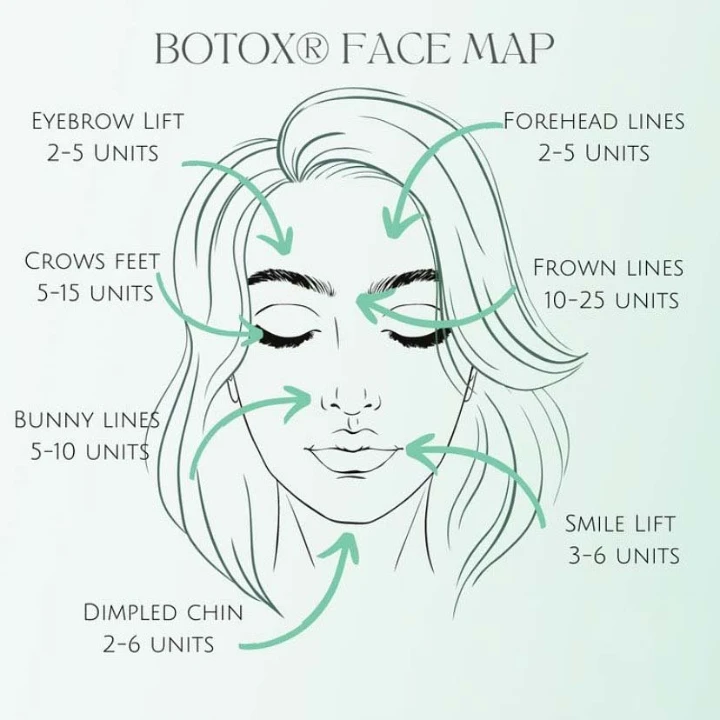
Botox Injection Sites Diagram Visualizing Perfection
One of these things is the Botox injection sites diagram, which is a graphic that shows where on the face specific Botox injections should go. This conceptual diagram is an important image to use both for the practitioner and client to understand what is expected and how precise application is essential for the best results.
They usually appear in zones, such as:
- The forehead: This treatment is for horizontal lines and wrinkles largely related to facial expressions.
- Around the eyes (crow’s feet): Treating the fine lines that appear at the outer corners of the eyes, created when you smile or squint.
- Between the eyebrows (glabellar lines): Target the vertical lines between your brows, which we call the “11” lines.
This information is helpful when estimating the results of treatment. For instance, addressing crow’s feet leads to smoother skin on the outer part of the eyes, which, in turn, helps you get a younger and more refreshed look. Doing the same with forehead lines can create a smoother, more relaxed-looking forehead, and when you smooth out glabellar lines (frown lines between the eyes).
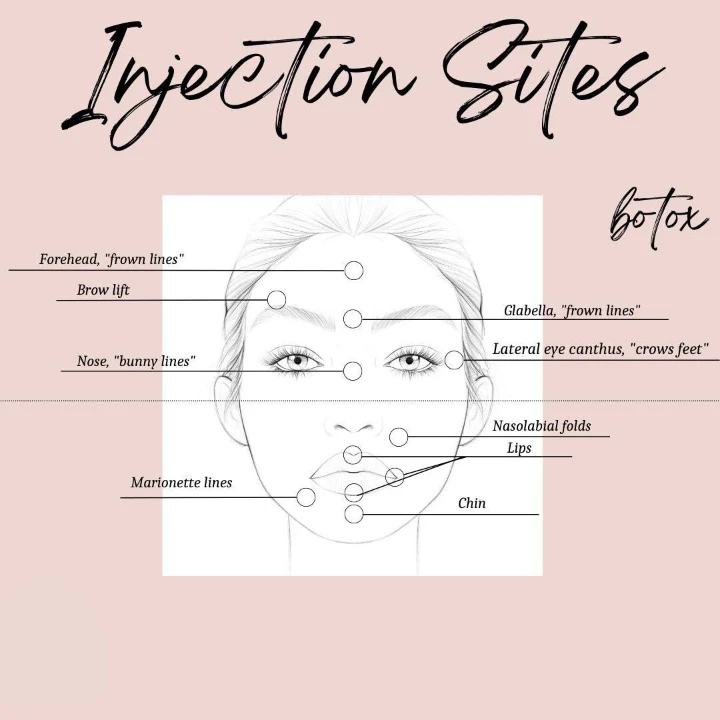
They appear less fierce resulting in a less intimidating facial expression. With the use of these diagrams, practitioners ensure that the Botox application is done safely and correctly, getting the most out of the Botox for the clients and giving them the best possible satisfaction from the treatment.
Botox Injection Face Map Targeting Precision
Because of this, a more granular model known as the Botox injection face map was developed to outline specific areas of injection. First, it subdivides bites to take an even more tailored perspective of the face for distinct needs and characteristics. This map is necessary for obtaining sensitive improvements that do not alter natural facial movements, which is very important to maintain a balanced and harmonized appearance.
This Botox injection face map will cover the following areas:
Forehead lines: Caused by raising eyebrows; horizontal lines that appear across the forehead.
Glabellar lines (11 lines between the eyebrows): Vertical lines that appear between the eyebrows, often due to frowning or squinting, and produce an angry or tired appearance.
Bunny lines (lines on the nose): Fine lines that appear on the sides of the nose when you scrunch up your face.
More abstract things a face map might be about also cover:
Crow’s feet: Fine lines that branch out from the eyes and are typically amplified by smiling or squinting.
Marionette lines: Lines that drop from the corners of the mouth to the chin which can make us look sad.
Lip lines: vertical lines above and on the lips, aggravated by puckering or smoking.
Chin Dimpling: Dappled chin due to muscle contractions.
This level of detailed mapping ensures that each injection device is placed accurately, improving the overall effectiveness and safety of treatment. And since the muscles and surrounding areas specifically are targeted.

It allows for these natural-looking results to stay true to human expression and movement. The specificity provided by the Botox injection face map is excellent in decreasing risks and increasing patient contentment as the improvements become safe and spontaneous.
Botox Face Chart Unlocking the Secrets to Youthful Skin
One such useful tool in the arsenal of Botox treatment is the Botox face chart. It has a deep dive into different facial landmarks and their injections so that you can get all shots on target with precision. Practitioners often use this chart for detailed planning and documentation of treatments which deliver good outcomes and safety to the process.
Things that can be included in the Botox face chart are:
-
Dynamic wrinkles (wrinkles caused by repetitive muscle movements) such as those of the forehead and the area of the eyes.
-
Zones for dynamic wrinkles, which are only observable with facial movement and usually situated around the mouth and cheeks the causes of dynamic wrinkles are the same causing of static wrinkles. Default Cell Style with relationship to where the wrinkles happen on the face, they can likewise be meant by whether the wrinkle is static or dynamic.
-
The cheeks, temples, and jawline are typical areas for volume loss with age.
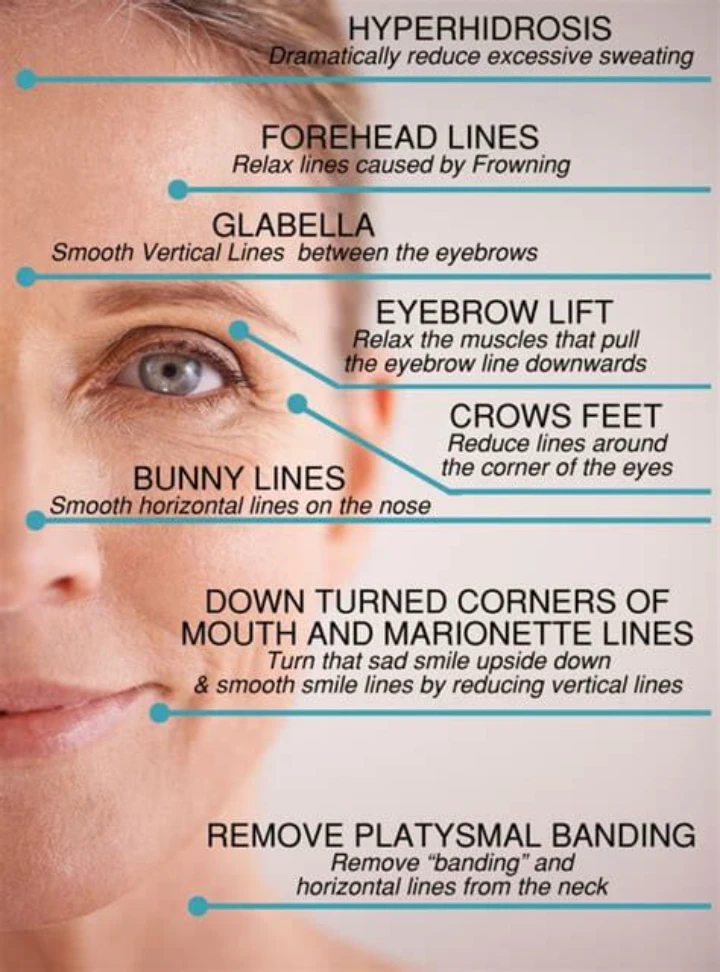
Combining these aspects will allow the practitioner to set up a complete, and custom treatment plan, within the context of the patient’s particular facial hierarchy and aging objectives. Anatomical mapping of the face allows the physician to inject only into a particular area, this in turn helps to pinpoint the perfect spot so an injection can deliver a very precise result for a happy patient without complications.
Botox Injection Sites Face Diagram A Closer Look
A Botox injection sites face map does just that but smaller scale. It involves smaller, targeted areas within the larger facial zones, to distinguish itself further away from Botox injections. This visually oriented flow diagram helps clinicians to identify specific sites for injections, thereby achieving a balanced therapeutic outcome with limited side effects.
This diagram usually shows:
- Orbicularis oculi (muscles around the eyes): Helps in eye movements, blinking, or squinting of the eyes.
- Frontalis (muscles of the forehead): Responsible for controlling the movements of the front of your forehead such as raising your eyebrows and creating horizontal lines in your forehead.
- Depressor anguli oris (muscles around the mouth): Used in frowning and pulling down the corners of the mouth.
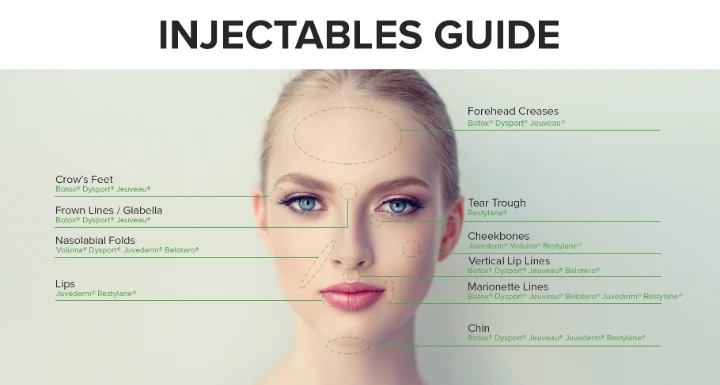
Knowing these muscles and what they do is beneficial in getting the result that you want, of course (lifting sagging eyebrows, reducing smile lines and creating a younger look). Through precise mapping of the injection sites, practitioners are able to tailor treatments to the specific concerns of each patient, with very personal and effective results.
Botox Chart Structuring Your Treatment Plan
The Botox chart is a useful tool for both clients and professionals to follow along and know where to inject the injection. It maps the Botox injection dosage and area so that predictable and more efficient results are achieved while minimizing the risk of complications.
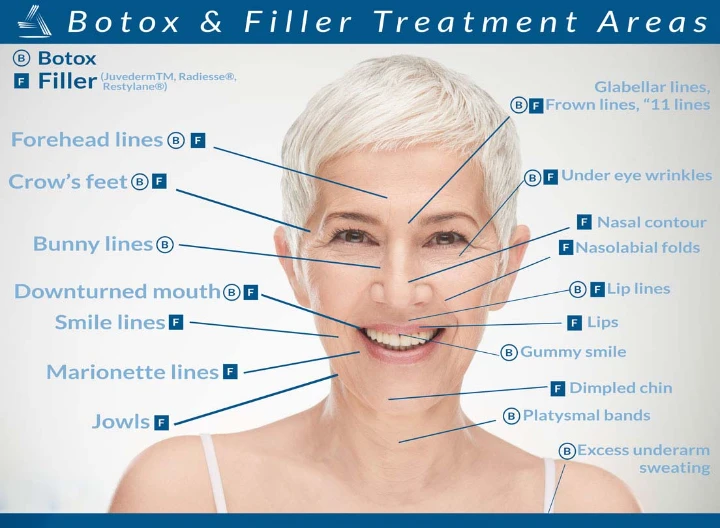
An example of a Botox chart includes the following important elements:
- Dosage recommendations for each facial area: This chart helps to give a guideline of not only the correct amount of Botox to use to obtain the desired effect but also to keep from overusing the product.
- Optimal injection points: Since Botox has the best effect in certain areas of the face, the injection points or locations are important to achieve the most natural-looking results with Botox.
- Frequency of treatments: Recommendations for how frequently Botox should be used to keep respects and side effects at bay.
A Botox chart Can Even come with contraindications and capacity side-effects & submit-treatment care instructions This chart serves as a great reference point, to refrain from beating labor in doing the structured and healthy approach to Botox treatments and hence results in better experience and satisfaction for both, the client and the practitioner.
Lower Face Botox Injection Sites Enhancing Your Smile
Looking at most people focus on the upper face, but the lower face Botox injection sites are as important. It is important to not forget about these places as well, such as the bordering of the jawline, the chin, and the front and sides of the neck, all of those areas can take good advances of Botox applications. By doing this work, one can get a fuller-looking and fresh facial image.
Common lower face injection sites are:
- Masseter muscles: Botox injections in this area create a slimming of the jaw, giving the appearance of a more V-shaped face, and can help with things like grinding your teeth or clenching your jaw.
- Mentalis muscle: Injecting this muscle can soften the appearance of “pebbly” chins to give a smooth, slender, and more youthful chin profile.
- Platysma bands: Injections in the neck bands can decrease necklines and sagging skin, resulting in a smoother and more elegant neckline.
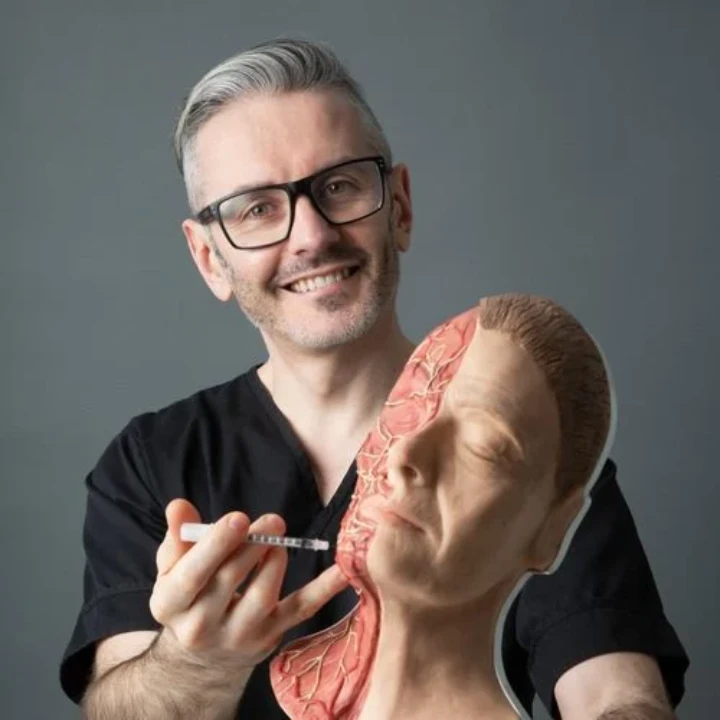
These areas when treated can enhance the overall aesthetics of the face providing into more balanced and harmonious facial structures that work with the upper face. Treating both the upper and lower face allows patients to experience a more subtle, yet comprehensive rejuvenation while improving the overall symmetry and aesthetics of the face.
Facial Diagram Botox Injection Sites Mapping the Journey
This facial map of Botox injection areas provides a comprehensive perspective on how the treatment is performed and with it, provides essential knowledge for enhancing results. The more meticulously the face is mapped out, the more integrative and dynamic the treatment strategy will be, where each botulinum toxin injection is targeted exactly where it is needed.
This facial diagram includes:
-
Musculo-fat compartments of the forehead, including frontalis, orbicularis oculi, and corrugator muscles Apprehensive of this fact, one can deal with dynamic wrinkles initiated by habitual facial expressions.
-
Wrinkles can be prevented by Botox crow’s feet, frown lines, and forehead So these are the zones where Botox can work and actively erase lines, and where it can be useful in staving off the development of new ones.
-
Enhancing zones of facial symmetry eg jawline, chin, and nasolabial folds. Achieving balance. Achieving balance and harmony in these areas can greatly enhance overall facial aesthetics.
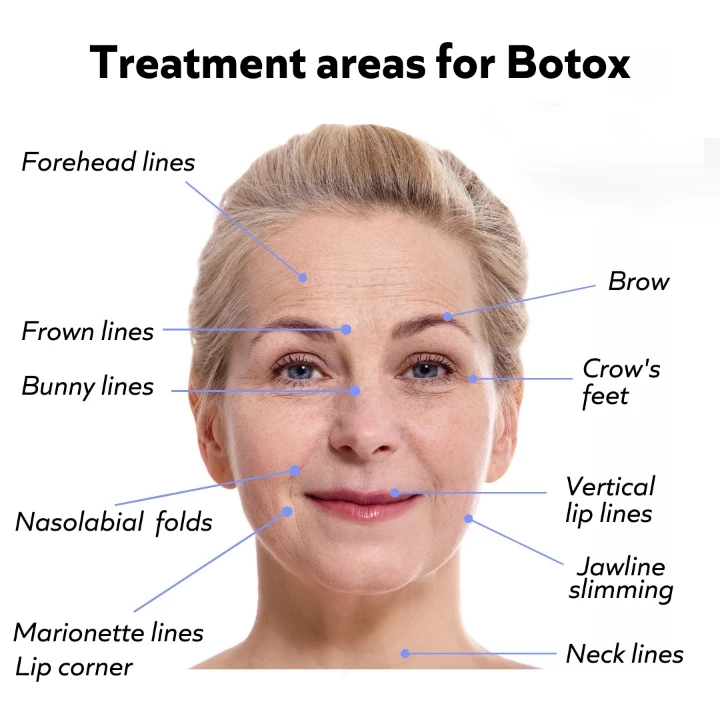
Botox Injection Map Charting the Course to Beauty
Botox Injection Map The Botox Injection Map is an elaborate and detailed guide to the course of Botox injections throughout the face. This is used for visualizing the treatment plan and its justifications after the injection site is shaped very well, making it sure the facial rejuvenation is precise and targeted.
The Botox injection map typically features:
- Injection points for common wrinkles such as crow’s feet, forehead lines, and frown lines.
-
Proactive Botox locations for starting anti-aging signs early.
- Zones for correcting asymmetry and achieving a harmonious look.
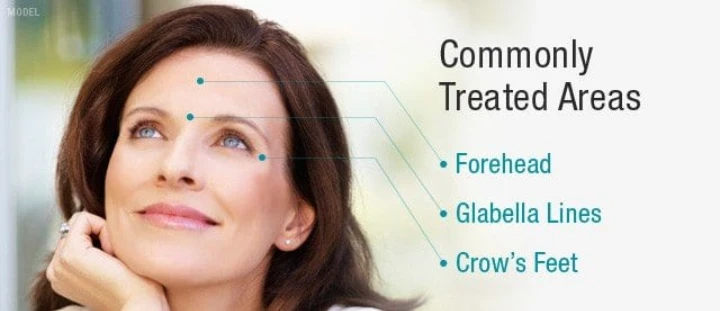
The practitioners take the help of this map in order to design an entirely balanced and effective plan of treatment specifically made as per the requirement of an individual ensuring his/her natural and best results. The map further serves to educate the patient on the procedure, showing them exactly what to anticipate and increasing confidence in the procedure. This integrated program benefits treatment results as well as patient satisfaction and safety.
Facial Mapping for Botox A Strategic Approach
If you allow me to help you we will apply a facial map for Botox; meticulously identifying the best injection sites for you. This approach considers the unique structural features of the face, global signs of aging, and favorite aspects of retaining a holistic management plan.
Facial mapping foundation fundamentals include:
- Assessing muscle movement and strength: When a patient is assessed for movement in the muscles, this gives the injector a good idea of how the muscles are moving and which muscles are the strongest in that area, this shows where Botox needs to go.
- Identifying areas of volume loss: With age, one may lose volume at a certain place of the face which results in droopy skin or hollow looks. This is why we map these areas as an aid in returning to a youthful appearance.
- Evaluating skin texture and elasticity: These help anticipate how the skin will react to Botox and give a suitable result that looks natural.
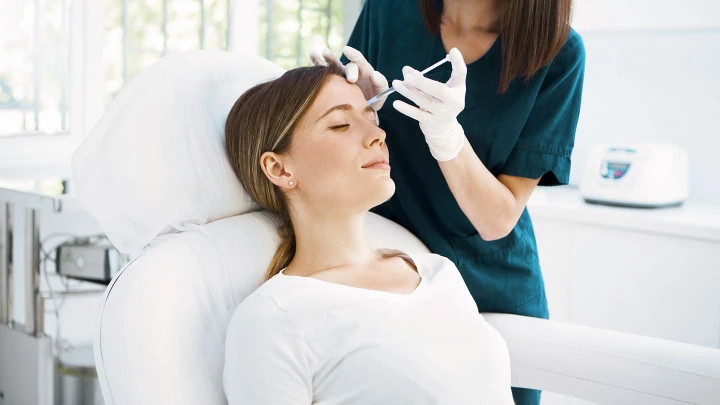
As a result, every Botox treatment is uniquely suited to the client’s face and aesthetic goals, offering an entirely personalized solution that can reveal, emphasize, and/or enhance natural beauty while treating particular issues. Practitioners also ensure detailed outcomes by targeting these elements.
Face Mapping for Botox Personalized Perfection
A customizable map is tailor-made for Botox. This exercise allows practitioners to offer more tailored advice taking into account the natural contours and dynamics of their client’s faces, leading to more natural and better results. This bespoke approach means that treatments are personally created to address the specific concerns and desires of each individual person.
The process of face mapping involves several key steps:
- Detailed facial analysis: This is how Botox works done by individual physicians who can assess a client’s facial characteristics, and identify where (and where not) Botox can be applied to achieve desired results.
- Customized injection plans: Using this analysis, a personalized injection plan is developed that not only targets the precise muscles and regions that are likely to prove most responsive to the treatment but reduces the possibility of unwanted side effects as well.
- Ongoing assessment and adjustments: This ongoing analysis of how the client responds to their Botox treatment will allow them to make minor tune-ups and adjustments to ensure that their desired aesthetic perfects itself over time.
All this customization makes it possible to get the best results, making clients appear refreshed and rejuvenated, not overdone. Aesthetic practitioners can provide results that rejuvenate, lift, harmonize, or simply emphasize natural beauty by addressing the unique structures of each face.
Botox Injection Chart Your Guide to a Flawless Face
A Botox injection chart is a very important tool whether doing your own Botox or for your Botoxociety community privacy policy. Buy now home about us testimonials media press release on the media. Media appearances products Procter-mueller medica rellabs contact us select page a botox injection chart is a very important tool whether doing your own Botox or for your Botoxociety community.
A Botox injection chart is an essential tool for planning and executing Botox treatments. With practical guidance on the safe and appropriate localization and promotion of dosing Botox to achieve the perfect results. This flowchart will guide practitioners on the best way to achieve results through the treatment and reduce the occurrence of complications.
Elements of a Botox injection chart include:
- Specific injection points: Only certain locations where Botox should be administered will give the desired results.
- Recommended dosages: Specific recommendations in terms of the quantity of Botox that should be injected into each site to obtain the expected results.
- Treatment intervals: This is the time frame a patient should wait between treatments to keep up with their treatment and ensure long-lasting results.
A lot simpler with this chart in place, maintaining consistency, and safety across treatments, and providing the services and best possible care a clients. The practitioners can deliver consistent results, increase the satisfaction of the clients, and gain faith in their services by sticking to the chart. Finally, the importance of an organized Botox injection chart cannot be emphasized enough, both from the point of view of the Botox provider, and that of the patient, in ensuring a successful Botox experience.
Points for Botox Injections The Key to Success
Key Points to Know About Botox Injections The reason for this is that these points are picked specifically because they can release the muscles that are responsible for creating wrinkles and lines. The way Botox works is by partially paralyzing the muscles created when we make facial expressions, and this is how the product will soften dynamic wrinkles. She points out that if you go with Botox injections, you should consider the following:
- Forehead lines: These are the lines that appear on your forehead when you raise your eyebrows. Injecting Botox in this area relaxes the muscles and creates a smoother-looking forehead.
- Crow’s feet: These are the little, radiating lines that develop outward from the corners of the eyes, and many times these become most marked once you smile or scrunch your eyes. The lines can be softened by targeting these points.
- Glabellar lines: Unsurprisingly also known as frown lines or “11” lines, these vertical lines occur between the eyebrows, and they can make you look angry or worried. Botox injections to this area will relax these muscles and soften this look.
Thus, practitioners will be able to diminish wrinkles and present patients with a rejuvenated look and no more wrinkles, by targeting these specific points. Regular treatments over periods of time can also help to reduce how deep these lines become, keeping your youthful look.
Conclusion
Botox is more of an art than a science, even the hardware store stuff. Below, check surstrumm face map to refer to and other such diagrams to study well will lead to a better outcome. If you are a Botox fanatic a beauty buff a dermatology customer, or over 30 looking to fight wrinkles, Here are some most popular Botox questions and answers to help you know your way around the Botox world.
Understanding the nuance of Botox injection sites allows you to tailor your treatments to help you build the relationship you want with your professional to develop a plan specific to what you want to improve on aesthetically. Now remember, the path to achieving and maintaining youthful, glowy skin is yours for the taking. if you know and understand how! Thus the worst adversary of skin aging takes about the next 2 days to explore the world of Botox, use the time and learn the world of aging solutions, and take control.
2 thoughts on “20+ Powerful Botox Face Map Placement Your Complete Guide”